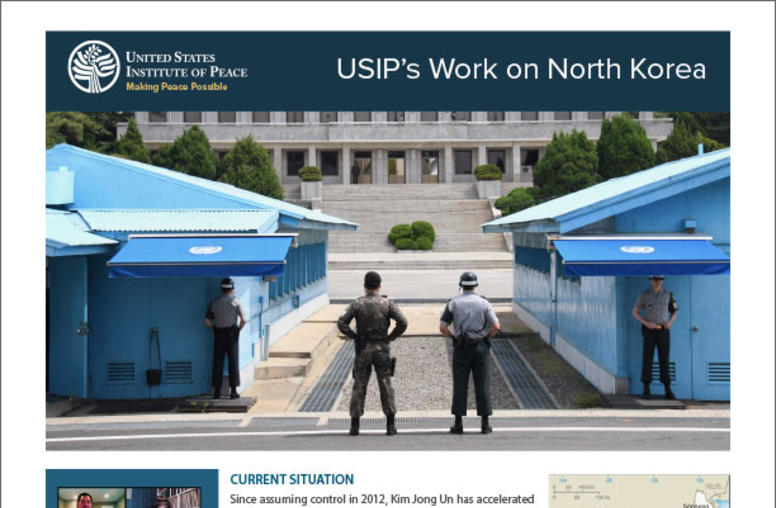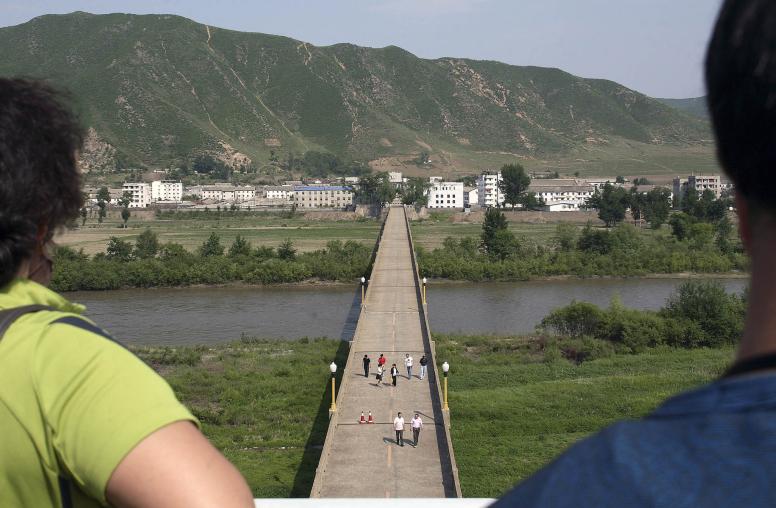Could Climate Change Compel North Korea to Cooperate?
Battered by climate-related disasters, North Korea needs help — and knows it.
Like much of the rest of the world, North Korea is experiencing more frequent and more intense climate-related disasters. In the last few years, it has seen its longest drought and longest rain season in over a century. In 2021, the country’s reclusive leader, Kim Jong Un, called for immediate steps to mitigate the dramatic impacts of climate change, which compound other challenges facing the country, like food insecurity. While North Korea is not exactly known for its efforts to cooperate with the international community, the severe threats posed by climate change could lead to broader engagement that serves Pyongyang’s interests, as well as the interests of the United States, South Korea and China, who all want peace and stability on the Korean Peninsula.

Both North Korea and the United States will need to be more flexible to spur bilateral engagement; until then, engagement with European and international counterparts may be the only way forward for North Korea on climate-related cooperation.
USIP’s Frank Aum and Lucy Stevenson-Yang look at the climate shocks threatening North Korea, the potential impact on the country’s governance and society and how the international community can help.
Are there specific climate shocks that North Korea is vulnerable to? What risk does climate-induced migration pose to the Korean Peninsula?
North Korea frequently experiences weather-related disasters, including typhoons, flooding and droughts, many of which could be amplified by climate change. In 2020, North Korea was hit by five major typhoons, three within a period of several weeks, causing major structural damage to buildings, roads, factories and water systems and internally displacing thousands of citizens. Since 1995, the country has recorded major flooding every year, except for four. Significant deforestation in North Korea has also caused soil erosion and depletion, which exacerbates the flooding problem. The Asian Disaster Reduction Center reported that in 2019, four out of 10 North Koreans were affected by natural disasters, which was attributable to the widescale impact of drought on North Korean food production.
The devastating impact of climate-related disasters on the agricultural sector, homes and infrastructure, and health system strains a country already in crisis due to government mismanagement and international sanctions. The Food and Agriculture Organization estimates that over 40% of the population has been undernourished since 2009, including 10.9 million North Koreans, or 42.4% of the population, from 2018 to 2020. A 2017 UNICEF survey found that only 61% of North Korean households and 44% of rural households have access to safely managed water. The current economic sanctions regime against North Korea as well as its self-imposed border lockdown due to COVID have also severely impeded the country’s normal economic activity and ability to receive humanitarian assistance.
Climate-related disasters will compound existing food insecurity. North Hwanghae province, a major breadbasket for North Korea, is projected to almost double its extreme flood risk by 2050. In addition, South Hamgyeong and North Pyongan, two other provinces responsible for a large portion of domestic food production, are set to experience “up to an additional 3 months of severe drought each year by 2035.”
North Korea’s poor infrastructure and disaster management systems have secondary effects that could threaten North Korean and regional stability. Major flooding near North Korea’s main nuclear facility at Yongbyon has raised fears about nuclear security and damage to the facility. Past environmental shocks have also contributed to North Korean migration to China from the northeastern provinces of North Hamgyeong and Ryanggang, raising human rights concerns as North Korea increases border surveillance and China resumes forced repatriation of refugees back to North Korea. In addition, North Korea has repeatedly opened floodgates at a dam near the inter-Korean border without providing notice to Seoul, which has caused flooding damage and casualties in South Korea.
How could these climate shocks impact North Korean society and governance in the coming years?
The impact of climate change on North Korea will likely intensify over the coming years, meaning more typhoons, flooding and droughts as well as related effects on governance, food security, migration, health and sanitary risks, and other human security issues. The 2021 U.S. National Intelligence Estimate highlighted that “North Korea’s poor infrastructure and resource management probably will weaken its ability to cope with increased flooding and droughts, exacerbating the country’s chronic food shortages.”
North Korea has recognized these challenges and risks for many years, going back to its severe famine during the 1990s. In 2014, North Korea enacted a Law on Disaster Prevention, Rescue and Rehabilitation, which helped to create a national disaster risk management system under the State Committee on Emergencies and Disaster Management. In 2019, North Korea developed a National Disaster Risk Reduction Strategy 2019-2030 to help align its approach with the guidelines of the Sendai Framework for Disaster Risk Reduction 2015-2030.
In his report to the Eighth Congress of the Korean Workers’ Party in January 2021, President Kim Jong Un referred to the “severe natural disasters that hit the country every year,” agricultural battles against “persistent and severe drought, flooding, and all kinds of shortages,” and past efforts to develop “a national system for disaster prevention and crisis management” that could “flexibly cope with all sorts of disasters including natural calamities.” His report also emphasized prospective steps that must be taken to address ecological and environmental issues, including “preventing natural disasters through an intensified campaign of afforestation and water conservation.”
There are signs that North Korea is starting to implement some disaster-risk reduction measures. The government appears to have improved early warning mechanisms for at-risk communities, including proactive weather forecasting and more frequent and timely radio broadcasts and text messaging, as well as better preparation and mobilization of personnel for disaster response. Reforestation and afforestation efforts also seem to be demonstrating progress.
What can the United States and the international community do to help alleviate the impact of climate shocks in North Korea?
North Korea is finicky about the areas in which it wants to engage or cooperate. It typically rejects discussions on topics deemed detrimental to its security, such as denuclearization or human rights, but can also ignore engagement on areas where it needs help, such as humanitarian assistance and COVID vaccines. For example, North Korea declined two million doses of the AstraZeneca vaccine and three million doses of the Sinovac vaccine from the international COVAX mechanism, likely due to a preference for the more effective mRNA vaccines. Pyongyang has also rejected U.S. and South Korean offers for humanitarian assistance out of concern that the aid might be politicized.
Nevertheless, given North Korea’s strong interest in addressing climate change and reducing disaster risks, these areas may represent potential areas for cooperation between North Korea, the United States and the international community. North Korea has signed on to various international agreements on climate and the environment, including the Vienna Convention for the Protection of the Ozone Layer, the U.N. Framework Convention on Climate Change, the 1997 Kyoto Protocol and the 2016 Paris Agreement. According to Choi Hyeonjung, director of the Center for Global Governance at the Asan Institute for Policy Studies in Seoul, “There is no other area in which North Korea wishes for and pursues international cooperation with such a proactive and open attitude as it does on environmental policy.”
Given the current diplomatic deadlock between the United States and North Korea, climate change engagement with North Korea, at least now, may be limited to non-U.S. or South Korean actors. European experts have suggested that European Union member countries may be promising counterparts based on their diplomatic ties and past humanitarian engagement with North Korea as well as their expertise on disaster risk management and support for international disaster risk reduction mechanisms (the EU is a signatory of the Sendai Framework). North Korean diplomats recognize this potential channel and have been reaching out to European experts.
Direct engagement with international organizations like the United Nations provides another avenue for climate and disaster risk cooperation. In 2021, North Korea submitted a Voluntary National Review of its implementation of the U.N. Sustainable Development Goals, signaling its willingness to work within international frameworks that align with its own national goals. The U.N. Office for Disaster Risk Reduction Office for Northeast Asia and the Global Education and Training Institute, located in Incheon, South Korea, provides a mechanism for cooperation that could also indirectly allow for inter-Korean engagement. In addition, researchers have suggested that the United States could take measures to support nongovernmental organizations and multilateral initiatives like the U.N. Green Climate Fund to facilitate dialogue with North Korea.
More robust and direct engagement between the United States and North Korea — whether it pertains to denuclearization, COVID vaccine assistance or climate change response — will require greater flexibility by both sides. Although North Korea may be concerned about the politicization of humanitarian issues, it should still seize opportunities for dialogue, such as the outstanding U.S. offer for open-ended talks. Likewise, the United States, given its dominant position, needs to consider adopting a more proactive, conciliatory approach to North Korea that alleviates some of its security concerns as an isolated country. History shows that when official U.S.-North Korea diplomacy was on the upswing, particularly in the 1990s and 2000s, academic and humanitarian engagement with North Korea flourished. Ultimately, a North Korea that becomes unstable because it cannot respond adequately to natural disasters presents not only a potential humanitarian catastrophe but also a geostrategic risk for the United States, South Korea and the region.



